| |
|
Xiamen Oil Paintings, Wholesale Direct!
|
|
100% hand painted, 100% cotton canvas, 100% money back if not satisfaction. |
|
|
|
|
ART WORKS INDEX
A
B
C
D
E
F
G
H
I
J
K
L
M
N
O
P
Q
R
S
T
U
V
W
X
Y
Z
|
|
ARTISTS INDEX
A
B
C
D
E
F
G
H
I
J
K
L
M
N
O
P
Q
R
S
T
U
V
W
X
Y
Z
|
|
|
|
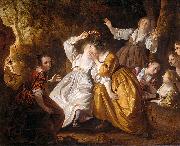 |
Jacob van Loo
|
|
(1614 - 26 November 1670) was a Flemish painter who is considered one of the Dutch Masters of the 17th Century. Van Loo is known for his conversational groupings, his use of a subtle color palette and his nudes. He was the founder of the Van Loo family of painters.
Van Loo was born in Sluis, Zeeland, in the Dutch Republic. Some sources have spe,culated that his father, Jan van Loo, may have been a notary, but more often his father is described as a painter from whom Jacob van Loo received his early training. Little is known of Van Loo's early history due to the destruction of the city archives in Sluis during World War II.
His early influences included Thomas de Keyser and Jacob Adriaensz Backer. In 1642, van Loo moved to Amsterdam, where his contemporaries included Rembrandt, Frans Hals, and Bartholomeus van der Helst. In 1643 he married the sister of the painter, Martinus Lengele. The couple had six children. They lived on Rozengracht in the Jordaan district of Amsterdam. Eglon van der Neer became one of his pupils. In 1660, Van Loo fled the city after fatally stabbing someone during an altercation at an inn. He was sentenced to death in absentia which forever prevented his return to Holland. Van Loo settled in Paris, where he was admitted to the Academie de peinture et de sculpture. He died in Paris in 1670.
Van Loo's work was done in the Baroque style that had originated in Rome. The Baroque style was popular throughout Europe during this period. Van Loo was a major influence on Johannes Vermeer as can be seen in Vermeer's painting, Diana and Her Companions.
Van Loo painted many portraits. Among his subjects were Johan Huydecoper van Maarssenveen; his sister, Leonara Huydecoper, who was married to Jan J. Hinlopen; Joan Ortt, who was later involved with Antoinette Bourignon; and his wife.
Jacob van Loo's son, Louis Abraham van Loo, was also a painter, as were his grandsons, Jean-Baptiste van Loo and Charles-Andra van Loo.
|
|
 |
Jacob Levecq
|
|
(1634 - 1675), was a Dutch Golden Age painter trained by Rembrandt.
According to Houbraken, who was his pupil during the last 9 months of his life, he had been trained by Rembrandt, but inherited a sum of money when his parents died, that he used to take care of himself, his two unmarried sisters and a blind half-brother. Houbraken could not recall much of his painting style, since he had been mostly sick while he was living in the house, and he no longer painted actively. In his younger years Levecq travelled to Paris and Sedan where he painted portraits, and on his return to Dordrecht became a portrait painter in the manner of Jan de Baen. When he died, Houbraken inherited a third of his prints, but regretted the fact that as a young boy with little experience in such matters, he only chose prints by Lucas van Leyden and Albert Durer, and had left the French prints for others, and so was very glad that he had received one anyway by Charles le Brun.
|
|
|
|
|
|
|
|
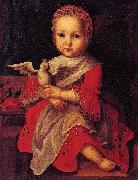 |
Ivan Vishnyakov
|
|
(1699 - 1761) was a Russian painter.
Vishnyakov was born in Moscow. He was a pupil of Louis Caravaque, a French artist, who worked in Russia. Vishnyakov worked in the painting department of the Ministry of Construction, and painted primarily portraits at that time. In 1739 he was promoted to the head of the department, and led the decoration of many palaces and churches in Moscow, Kiev, and Saint Petersburg. He died in Saint Petersburg in 1761.
|
|
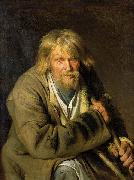 |
Ivan Nikolaevich Kramskoi
|
|
(June 8 (O.S. May 27), 1837 ?C April 6 (O.S. March 24), 1887; was a Russian painter and art critic. He was an intellectual leader of the Russian democratic art movement in 1860-1880.
Kramskoi came from a poor petty-bourgeois family. From 1857 to 1863 he studied at the St. Petersburg Academy of Arts; he reacted against academic art and was an initiator of the "revolt of fourteen" which ended with the expulsion from the Academy of a group of its graduates, who organized the Artel of Artists
Influenced by the ideas of the Russian revolutionary democrats, Kramskoi asserted the high public duty of the artist, principles of realism, and the moral substance and nationality of art. He became one of the main founders and ideologists of the Company of Itinerant Art Exhibitions (or Peredvizhniki). In 1863-1868 he taught at the drawing school of a society for the promotion of applied arts. He created a gallery of portraits of important Russian writers, scientists, artists and public figures (Lev Nikolaevich Tolstoy, 1873, Ivan Shishkin, 1873, Pavel Mikhailovich Tretyakov, 1876, Mikhail Saltykov-Shchedrin, 1879, Sergei Botkin, 1880) in which expressive simplicity of composition and clarity of depiction emphasize profound psychological elements of character. Kramskoi's democratic ideals found their brightest expression in his portraits of peasants, which portrayed a wealth of character-details in representatives of the common people.
In one of Kramskoi's most well known paintings, Christ in the Desert (1872, Tretyakov gallery), he continued Alexander Ivanov's humanistic tradition by treating a religious subject in moral Cphilosophical terms. He imbued his image of Christ with dramatic experiences in a deeply psychological and vital interpretation, evoking the idea of his heroic self-sacrifice.
Aspiring to expand the ideological expressiveness of his images, Kramskoi created art that existed on the cusp of portraiture and genre-painting ("Nekrasov during the period of 'Last songs,'" 1877-C78; "Unknown Woman," 1883; "Inconsolable grief," 1884; all in Tretyakov gallery). These paintings disclose their subjects' complex and sincere emotions, their personalities and fates. The democratic orientation of Kramskoi's art, his acute critical judgments about it, and his persistent quest for objective public criteria for the evaluation of art exerted an essential influence on the development of democratic art and aesthetics in Russia in the last third of the nineteenth century.
|
|
 |
Ivan Kramskoi
|
|
(June 8 (O.S. May 27), 1837 C April 6 (O.S. March 24), 1887)
|
|
|
|
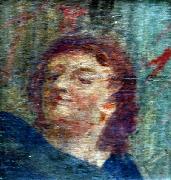 |
Ivan Grohar
|
|
Ivan Grohar (15 June 1867 - 19 April 1911) was a Slovene Impressionist painter. Together with Rihard Jakopič, Matej Sternen and Matija Jama, he is considered one of the leading figures of Slovene impressionism in the fin de siecle period.
Grohar was born in the Upper Carniolan village of Spodnja Sorica, then part of the Austro-Hungarian Empire. From an early age, he showed an interest in art but he could not develop his talent because he was an orphan and lived in poverty. In 1888, the local vicar Anton Jamnik sent him to an exhibition in the nearby town of Škofja Loka, enabling him to spend the summer working in the town of Kranj under the supervision of the church painter Matija Bradaška. He also travelled to Zagreb, where he worked in the atelier of Spiridion Milanesi, until he was conscripted into the Austro-Hungarian Army. He disliked the military life, so he deserted and fled to Venice, in Italy. Left with nothing, he appealed to the Austro-Hungarian consulate. In 1889 a court sentenced him to a short stay in prison and extended his military service by one year.
Ivan Grohar: Brna from 1899In 1892, he applied to the Carniolan Provincial Diet for financial assistance to study at the Graz school of painting, which he received. Two years later, he applied for assistance to study at the Academy of Fine Arts in Vienna. This assistance was also approved, but despite his excellent exam result, he was not accepted to the Academy because he had not finished his studies in Graz. He continued his schooling in Graz and finished it at the end of 1894. In August 1896, he opened his own atelier in Škofja Loka. He also worked in Munich, where he attended Anton Ažbe school of art. Back home, he befriended the impressionist painter Rihard Jakopič. In autumn of 1900, he took part in the first Slovene Artistse Exhibition, organised by the Slovene Artistic Association (Slovensko umetniško društvo, SUD). He was elected to the position of treasurer of the SUD, but illegally borrowed money from the association, for which he was sentenced to three monthse imprisonment. On his release, he left for Vienna.
|
|
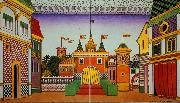 |
Ivan Bilibin
|
|
(Russian, 16 August [O.S. 4 August] 1876 - 7 February 1942) was a 20th-century illustrator and stage designer who took part in the Mir iskusstva and contributed to the Ballets Russes. Throughout his career, he was inspired by Slavic folklore.
Ivan Bilibin was born in a suburb of St. Petersburg. He studied in 1898 at Anton Ažbe Art School in Munich, then under Ilya Repin in St. Peterburg. In 1902-1904 Bilibin travelled in the Russian North, where he became fascinated with old wooden architecture and Russian folklore. He published his findings in the monograph Folk Arts of the Russian North in 1904. Another influence on his art was traditional Japanese prints.
Bilibin gained renown in 1899, when he released his illustrations of Russian fairy tales. During the Russian Revolution of 1905, he drew revolutionary cartoons. He was the designer for the 1909 premiere production of Nikolai Rimsky-Korsakov's The Golden Cockerel. The October Revolution, however, proved alien to him. After brief stints in Cairo and Alexandria, he settled in Paris in 1925. There he took to decorating private mansions and Orthodox churches. He still longed for his homeland and, after decorating the Soviet Embassy in 1936, he returned to Soviet Russia. He delivered lectures in the Soviet Academy of Arts until 1941. Bilibin died during the Siege of Leningrad.
|
|
|
|
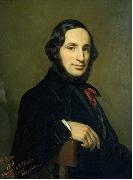 |
Ivan Aivazovsky
|
|
July 29, 1817 C May 5, 1900) was a Russian painter of Armenian descent, most famous for his seascapes, which constitute more than half of his paintings.Aivazovsky was born in the town of Feodosiya, Crimea, to a poor Armenian family. His parents family name was Aivazian. Some of artist's paintings bear a signature, in Armenian letters, "Hovhannes Aivazian" (Յովհաննէս Այվազեան). His talent as an artist earned him sponsorship and entry to the Simferopol gymnasium ??1 and later the St.Petersburg Academy of Arts, from which he graduated with the gold medal. Earning awards for his early landscapes and seascapes, he went on to paint a series of portraits of Crimean coastal towns before traveling throughout Europe. In later life, his paintings of naval scenes earned him a longstanding commission from the Russian Navy.
In 1845, Aivazovsky went to Istanbul upon the invitation of Sultan Abdelmecid, a city he was to travel to eight times between 1845-1890.
|
|
 |
Ivan Vishnyakov
|
|
1699-1761
Russian Ivan Vishnyakov Gallery
Russian painter. He trained at the Admiralty College under Vasily Gruzinets (1667-1739) and in 1727 joined the staff of the Office of Buildings with the rank of apprentice, working for a time under Louis Caravaque (1684-1754). In 1739 he became a Master and head of the Office department of paintings. He contributed to the monumental and decorative works, which he also supervised, in the palaces and churches of St Petersburg and environs, Moscow and Kiev, and in the decoration of triumphal arches in Moscow and St Petersburg.
|
|
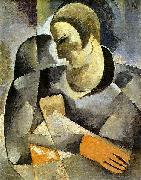 |
Ismael Nery
|
|
Ismael Nery (October 9, 1900 - April 6, 1934) was a Brazilian artist.
Born in Belem, Pare of Dutch, Native-Brazilian and African ancestry,[1] he studied at the Escola Nacional de Belas Artes (National School of Fine Arts) in Rio de Janeiro and at the Academie Julian in Paris. He created numerous paintings, wrote many poems and also helped design Brazil's National Patrimony of the Treasury department. Nery married a poet, Adalgisa Nery, in 1922. He contracted tuberculosis in 1931, and died of it in 1934.
|
|
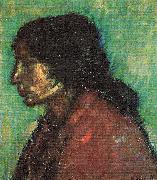 |
Isidre Nonell
|
|
(November 30, 1873, Barcelona, Spain - February 21, 1911, Barcelona) a Catalonian painter and drawer belonging to post-impressionism known for his expressive portrayal of the socially marginalized of Barcelona society. (He is also said to belong to modernism and postmodernism.)
Isidre Nonell was born in 1872 (not in 1873 as indicated by some biographers). His parents, Isidre Nonell i Torras de Arenys de Mar and Àngela Monturiol i Franc of Barcelona, owned a small but prosperous factory of soup noodles. Together with his childhood friend, Joaquim Mir, with whom he attended the same school in the neighborhood of Sant Pere in the old part of town in Barcelona, he developed artistic ambitions at an early age.
His early teachers included Josep Mirabent, Gabriel Martenez Alt and Llu Graner. From 1893 to 1895 he studied at the Escola de Belles Arts de Barcelona (Fine Arts School of Barcelona). He met Ricard Canals, Ramen Pichot, Juli Vallmitjana, Adrie Gual, and Joaquin Sunyer with whom he developed an interest in landscape painting, studying light. The study of sunlight and its effects on color were a main part of Impressionism, which was then active. They were called the "Saffron Group" for the warm tones they used, as well as the "Sant Marte Group" after the town they painted in.
In 1894, he began producing illustrations for La Vanguardia. He later drew for other periodicals, including LeEsquella de la Torratxa, Barcelona Cemica, Pel & Ploma, and Forma.
In 1896, Nonell went with Ricard Canals and Juli Vallmitjana to the spa town of Caldes de Boe in the Catalonian Pyrenees to work at the spa run by Vallmitjana's family. There, he saw a large number of people suffering from the illness of cretinism, which became a subject of his paintings.
In February 1897, he went to Paris with Ricard Canals. There he exhibited and shared a studio with Picasso. He returned to Barcelona in 1900. At the beginning of 1901, he made paintings of women, such as gypsy and working-class women, and still lifes. He exhibited in the Sala Par in Barcelona twice, in 1902 and 1903. The reaction to his works of poor gypsy women was very hostile.
|
|
 |
Isaak Soreau
|
|
painted Basket with fruit and plum leaves in c. 1640
|
|
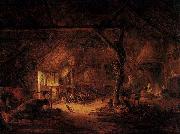 |
Isaac van Ostade
|
|
(bapt. June 2, 1621, Haarlem - buried October 16, 1649, Haarlem) was a Dutch genre and landscape painter.
Van Ostade began his studies under his brother, Adriaen, with whom he remained till 1641, when he started his own practice. At an early period he felt the influence of Rembrandt, and this is apparent in a Slaughtered Pig of 1639, in the gallery of Augsburg. He soon found a style more suited to his own inclinations. He produced pictures in 1641-1642 on the lines of his brother - amongst these, the Five Senses, which Adrian afterwards represented by a Man reading a Paper, a Peasant tasting Beer, a Rustic smearing his Sores with Ointment and a Countryman sniffing at a Snuff-box. A specimen of Isaac's work at this period may be seen in the Laughing Boor with a Pot of Beer, in the museum of Amsterdam; the cottage interior, with two peasants and three children near a fire, in the Berlin museum; a Concert, with people listening to singers accompanied by a piper and flute player, and a Boor stealing a Kiss from a Woman, in the Lacaze collection at the Louvre.
The interior at Berlin is lighted from a casement in the same Rembrandtesque style as Adrian's interior of 1643 at the Louvre. He received low prices for this kind of painting, in which he could only remain subordinate to his brother. Gradually he abandoned Adrian's cottage subjects for landscapes in the fashion of Esaias van de Velde and Salomon van Ruysdael. Once only, in 1645, he reverted to the earlier mode, when he produced the Slaughtered Pig, with a boy puffing out a bladder, in the museum of Lille.
Isaac's progress in his new path was greatly facilitated by his previous experience as a figure painter; and, although he now selected his subjects either from village high streets or frozen canals, he gave fresh life to the scenes by depicting animated groups of people with a refined and searching study of picturesque contrasts. He did not live long enough to bring his art to the highest perfection. He died on 16 October 1649 having painted about 400 pictures (see H de Groot, 1910).
The first manifestation of Isaac's surrender of Adrian's style is apparent in 1644 when the skating and sledging scenes were executed which we see in the Lacaze collection and the galleries of the Hermitage, Antwerp and Lille. Three of these examples bear the artists name, spelled Isack van Ostade, and the dates of 1644 and 1645. The roadside inns, with halts of travellers, form a compact series from 1646 to 1649. This is the last form of Isaac's art and has very distinct peculiarities. The air which pervades his composition is warm and sunny, yet mellow and hazy, as if the sky were veiled with a vapour coloured by moor smoke. The trees are rubbings of umber, in which the prominent foliage is tipped with touches hardened in a liquid state by amber varnish mediums. The same principle applied to details such asglazed bricks or rents in the mud lining of cottages gives an unreal and conventional stamp to them.
These quirks are overcome by his broad contrasts of light and shade and the masterly figures of horses, riders, travellers, rustics, quarrelling children, dogs, poultry and cattle. A favorite place is always given to the white horse, which seems as invariable an accompaniment as the grey in the skirmishes and fairs of Philip Wouwerman.
Isaac displays the best qualities in winter scenes. The absence of foliage, the crisp atmosphere and the calm air of cold January days, unsullied by smoke or vapour, preclude the use of the brown tinge, and leave the painter no choice but to ring the changes with a great variety of opal tints. Then the figures emerge with masterly effect on the light background. Amongst the roadside inns it is worth noting those in the collections of Buckingham Palace, the National Gallery, London, the Wallace Collection and Holford collections in England, the Louvre, Berlin, Hermitage and Rotterdam museums and the Rothschild collection at Vienna. The finest of the ice scenes is the famous one at the Louvre.
|
|
|
|
|
|
|
|
|
|
|
|
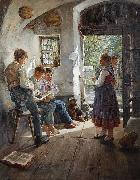 |
Hugo Loffler
|
|
1859-1935
painted Preparing for the lesson in 1896
|
|
|
|
|
|
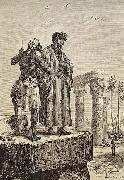 |
Hippolyte Leon Benett
|
|
Muḥammad ibn Baṭeṭah (Arabic: أبو عبد الله محمد ابن بطوطة), or simply Ibn Battuta, also known as Shams ad CD in (February 25, 1304-1368 or 1369), was a Muslim Moroccan explorer, known for his extensive travels published in the Rihla (literally, "The Journey"). Over a period of thirty years, he visited most of the known Islamic world, including North Africa, the Horn of Africa, West Africa, Southern Europe and Eastern Europe in the West, to the Middle East, South Asia, Central Asia, Southeast Asia and China in the East, a distance surpassing his near-contemporary Marco Polo. Ibn Battuta is considered one of the greatest travellers of all time. He journeyed more than 75,000 miles (121,000 km), a figure unsurpassed by any individual explorer until the coming of the Steam Age some 450 years later.
|
|
|
|
|
|
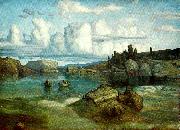 |
hertervig
|
|
Lars Hertervig (February 16, 1830 - January 6, 1902) was a Norwegian painter. His semi-fantastical work with motives from the coastal landscape in the traditional district of Ryfylke is regarded as one of the peaks of Norwegian painting.
Lars Hertervig was born in 1830 at Hattarvagen, in the municipality Tysvar in Norway, from which the family name derives, on the west coast of Norway, north of Stavanger. His family were poor, Quaker farmers. Hertervig studied painting at the Arts Academy of Dusseldorf from 1852, as the private pupil of Hans Gude, until he experienced a temporary mental breakdown two years later, and moved back to the Stavanger area. In October 1856, Hertervig entered Gaustad asylum.
|
|
|
|
 |
Herbert James Draper
|
|
(1863 - 22 September 1920) was an English Classicist painter whose career began in the Victorian era and extended through the first two decades of the 20th century.
Born in London, the son of a jeweller named Henry Draper and his wife Emma,he was educated at Bruce Castle school in Tottenham and then went on to study art at the Royal Academy. He undertook several educational trips to Rome and Paris between 1888 and 1892, having won the Royal Academy Gold Medal and Travelling Studentship in 1889. In the 1890s he worked also as an illustrator, settling in London. In 1891 he married his wife Ida , with whom he had a daughter, Yvonne.He died of arteriosclerosis at his home at 15, Abbey Road, N.W.8 on 22 September 1920
|
|
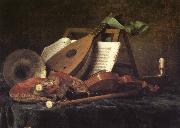 |
henry wadsworth longfellow
|
|
1807-C82, American poet, b. Portland, Maine, grad. Bowdoin College, 1825. He wrote some of the most popular poems in American literature, in which he created a new body of romantic American legends. Descended from an established New England family, after college he spent the next three years in Europe, preparing himself for a professorship of modern languages at Bowdoin, where he taught from 1829 to 1835. After the death of his young wife in 1835, Longfellow traveled again to Europe, where he met Frances Appleton, who was to become his second wife after a long courtship. She was the model for the heroine of his prose romance, Hyperion (1839). From 1836 to 1854, Longfellow was professor of modern languages at Harvard, and during these years he became one of an intellectual triumvirate that included Oliver Wendell Holmes and James Russell Lowell. Although a sympathetic and ethical person, Longfellow was uninvolved in the compelling religious and social issues of his time; he did, however, display interest in the abolitionist cause.
|
|
|
|
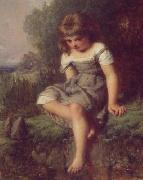 |
Henry Lejeune
|
|
(12 December 1819 - 5 October 1904) was an English painter of landscapes, genre, literary and biblical scenes. He became well-known for his genre paintings of children.
Henry Le Jeune was born in London, the son of Anthony Le Jeune, a professional musician of Flemish origin, and the third of five children. After showing an early interest in art he was encouraged by his family to study the art collections in the British Museum.
In 1834 Le Jeune was admitted to the Royal Academy where, after winning 4 silver medals in succession, he won a gold medal in 1841 for the biblical painting "Samson Bursting his Bonds". He first exhibited at the Royal Academy in 1840 with a work entitled "Joseph Interpreting the Dream of Pharaoh's Chief Butler".
From 1845-48 he taught at the Government School of design at Somerset House, and from 1848-64 was curator and instructor at the Royal Academy. He was elected an Associate of the Royal Academy (ARA) in 1863 and an honorary retired associate in 1886.
Le Jeune married Dorothy Lewis (1815-1864) on 21 June 1844 and had five sons and three daughters. He lived in London all his life, dying in Hampstead in 1904.
|
|
|
|
|
|
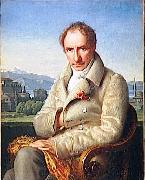 |
Henriette Lorimier
|
|
(7 August 1775, Paris - 1 April 1854) was a popular portraitist in Paris at the beginning of Romanticism.
She lived with the French diplomat and philhellene writer Francois Pouqueville (1770-1838).
student of the history painter Jean-Baptiste Regnault, she soon exhibited fine portraits and genre paintings at the Paris' Salons from 1800 to 1806 and from 1810 to 1814.
In 1805 Princess Caroline Murat-Bonaparte, a sister of the Emperor, purchased "La Chevre Nourriciere" a painting exhibited at the 1804 Salon and in 1806 Henriette Lorimier was awarded a First Class Medal for her painting of "Jeanne de Navarre" which was then purchased by the Empress Josephine de Beauharnais, consort of the Emperor Napoleon Ier.
|
|
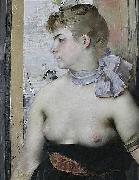 |
Henri-Lucien Doucet
|
|
(1856-1895) was a French figure and portrait painter, born in Paris, where he studied under Lefebvre and Boulanger, and in 1880 won the Prix de Rome. His pictures are usually piquant, sparkling representations of modern life, eminently Parisian in style, but the audacious realism of his earlier work is not maintained in his later, which is somewhat characterless. His portraits in pastel are also notable.
His most widely known picture is Apres le bal (After the Ball, 1889). Other excellent examples are the portraits of Celestine Galli-Marie as Carmen (1884, Marseille Museum), La princesse Mathilde Laetitia Wilhelmine Bonaparte and My Parents (1890, Lyons Museum), A Spanish Woman (Pontoise Museum), and Nude Figure (1890). He was awarded a first-class medal for pastel in 1889 and the Legion of Honour in 1891.
His painting A Skating Party, of 1893, was exhibited at the Chicago World Fair or the World's Columbian Exposition, which was held from May to October 1893 in Chicago in honour of the 400th anniversary of Columbus' discovery of the New World. Goupil made a limited edition first impression photogravure of the painting.
|
|
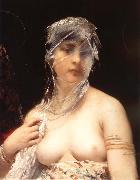 |
Henri Lucien Doucet
|
|
France
1856-1895
was a French figure and portrait painter, born in Paris, where he studied under Lefebvre and Boulanger, and in 1880 won the Prix de Rome. His pictures are usually piquant, sparkling representations of modern life, eminently Parisian in style, but the audacious realism of his earlier work is not maintained in his later, which is somewhat characterless. His portraits in pastel are also notable. His most widely known picture is Apres le bal (After the ball, 1889). Other excellent examples are the portraits of Madame Galli-Marie as Carmen (1884, Marseille Museum); the Princesse Mathilde and My Parents (1890, Lyons Museum); A Spanish Woman (Pontoise Museum); and a Nude Figure (1890). He was awarded a first-class medal for pastel in 1889 and the decoration of the Legion of Honor in 1891.
|
|
 |
Henri Leys
|
|
(18 February 1815 - 26 August 1869), also known as Henri Leys, was a Belgian painter and printmaker.
Henri Leys was born and died in Antwerp. He studied with Mathieu Ignace Van Bree (1773-1839) at the Koninklijke Academie voor Schone Kunsten in Antwerp and then with his brother-in-law Ferdinand De Braekeleer (1792-1883). At the start of his career, he worked with the Belgian Romantic painter Egide Charles Gustave Wappers (1803-1874). Both artists were interested in nationalistic subjects painted in styles that owe much to the example of 16th- and 17th-century Flemish painting. In 1835 Leys went to Paris where he visited the studio of Eugene Delacroix and met Paul Delaroche. During the 1840s, Leys began painting scenes set in 16th-century Antwerp, combining details studied from life with a deliberately archaizing style reminiscent of 16th-century German painters like Albrecht Derer and Quinten Matsys. Some of the pictures have specific historical subjects, but others are genre scenes. With these pictures, he earned a following among many younger artists in Belgium as well as a considerable reputation in France, where he won a gold medal at the International Exhibition in Paris in 1855 for his historical painting The Mass of Berthal de Haze (Royal Museum of Fine Arts, Brussels). In 1862 Leys was created a baron by King Leopold I. At the time of his death, he was engaged in decorating the interior of the Antwerp Town Hall with monumental frescoes depicting the city's history (1863-9). There are easel replicas of these in Brussels. Among the artists who studied with him are James Tissot and Sir Lawrence Alma-Tadema. His best-known pupil is his nephew Henri De Braekeleer (1840-1888).
|
|
|
|
 |
Henri Lehmann
|
|
German Neoclassical Painter, 1814-1882,was a French historical and portrait painter, born in Kiel, Schleswig. He was a pupil of his father, Leo Lehmann, and of Ingres in Paris, where he opened a studio in 1847, after having become naturalized. His brother Rudolf Lehmann was a well-known portrait artist.
|
|
 |
Henri Lebasque Prints
|
|
French Painter, 1865-1937
was born in 1865 at Champign?? (Maine-et-Loire). He started his education at the Ecole des Beaux-Arts d??Angers, and moved to Paris in 1886. Here, Lebasque started studying under L??on Bonnat, and assisted Humbert with the decorative murals at the Panth??on. Around this time, Lebasque met Camille Pissarro and Auguste Renoir, who later would have a large impact on his work.
Lebasque's vision was coloured by his contact with younger painters, especially Edouard Vuillard and Pierre Bonnard, founders of the The Nabis' Group and the Intimists who first favoured the calm and quietude of domestic subject matter. From his first acquaintance with Georges Seurat and Paul Signac, Lebasque learnt the significance of a colour theory which stressed the use of complementary colours in shading.
Lebasque was a founding member of the Salon d'Automne in 1903 with his friend Henri Matisse. Two years later a group of artists exhibited there including Georges Rouault, Andr?? Derain, Edouard Vuillard and Henri Matisse while keeping solid links with other artists such as Gustave Rouault, Raoul Dufy, Louis Valtat and especially Henri Manguin, who made him discover the south of France.
His time in South of France would lead to a radical transformation in Lebasque??s paintings, changing his colour palette forever. Other travels included the Vend??e, Normandie and Brittany, although Lebasque would always prefer the small idyllic villages of the South of France.
Lebasque had some commercial success during his lifetime. He worked on the decorations at the theatre of the Champs-Elys??es and of the Transatlantique sealiner.
Lebasque died at Cannet, Alpes Maritimes in 1937.
His work is represented in French museums, notably Angers, Geneva (Petit Palais), Lille (Mus??e des Beaux-Arts), Nantes and Paris (Mus??e d??Orsay) as well as many more around the world. Famed as a painter of 'joy and light', Lebasque is admired for the intimacy of his subject matter and his unique delight in colour and form.
|
|
 |
Henri Le Sidaner
|
|
(August 7, 1862 - July 1939) was an Intimist painter born to a French family in Port Louis, Mauritius. In 1870 he and his family settled in Dunkirk. Le Sidaner received most of his tutelage from the École des Beaux-Arts under the instruction of Alexandre Cabanel but later broke away due to artistic differences.
He travelled extensively throughout France and also visited many cities around the globe such as London, New York, Venice and Paris as well as some small villages throughout Europe. Le Sidaner exhibited at the Salon, the Galeries Georges Petit in Paris and the Goupil Gallery in London. He lived in Gerberoy, France.
Le Sidaner's work was mentioned in Marcel Proust's novel In Search of Lost Time. In Sodom and Gomorrah, the narrator mentions that an eminent barrister from Paris had devoted his income to collecting the paintings of the "highly distinguished" but "not great" Le Sidaner.
|
|
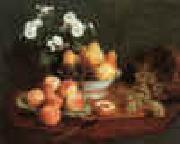 |
Henri Fantin-Latour
|
|
French 1836-1904
Henri Fantin Latour Locations
Bure) French painter and printmaker. He was trained by his father, a portrait painter, and at the Ecole des Beaux-Arts. Though he associated with progressive artists (Gustave Courbet, Eugene Delacroix, Edouard Manet), he was a traditionalist best known for his portraits and still lifes with flowers. His portrait groups, reminiscent of 17th-century Dutch guild portraits, depict literary and artistic persons of the time; his flower paintings were especially popular in England, thanks to James McNeill Whistler and John Everett Millais, who found patrons to support him. His later years were devoted to lithography.
|
|
 |
Henri Toulouse-Lautrec
|
|
French Post-Impressionist Painter and Printmaker, 1864-1901
Henri de Toulouse-Lautrec, a direct descendant of the counts of Toulouse, was born on Nov. 24, 1864, at Albi. His eccentric father lived in provincial luxury, hunting with falcons and collecting exotic weapons. Henri began to draw at an early age. He suffered a fall in 1878 and broke one femur; in 1879 he fell again and broke the other one. His legs did not heal properly; his torso developed normally, but his legs were permanently deformed.
Encouraged by his first teachers, the animal painters Rene Princeteau and John Lewis Brown, Toulouse-Lautrec decided in 1882 to devote himself to painting, and that year he left for Paris. Enrolling at the Ecole des Beaux-Arts, he entered the studio of Fernand Cormon. In 1884 Toulouse-Lautrec settled in Montmartre, where he stayed from then on, except for short visits to Spain, where he admired the works of El Greco and Diego Velazquez; Belgium; and England, where he visited Oscar Wilde and James McNeill Whistler. At one point Toulouse-Lautrec lived near Edgar Degas, whom he valued above all other contemporary artists and by whom he was influenced. From 1887 his studio was on the Rue Caulaincourt next to the Goupil printshop, where he could see examples of the Japanese prints of which he was so fond.
Toulouse-Lautrec habitually stayed out most of the night, frequenting the many entertainment spots about Montmartre, especially the Moulin Rouge cabaret, and he drank a great deal. His loose living caught up with him: he suffered a breakdown in 1899, and his mother had him committed to an asylum at Neuilly. He recovered and set to work again. He died on Sept. 9, 1901, at the family estate at Malrome.
|
|
|
|
|
|
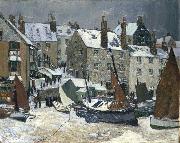 |
Hayley Lever
|
|
(28 September 1876 - 6 December 1958) was an Australian-American painter, etcher, lecturer and art teacher.
Richard Hayley Lever was born in Australia on 28 September 1876. Lever demonstrated artistic talent early on, and spent his entire life focusing on this as his craft.
|
|
|
|
|
|
|
|
|
| Wholesale China Oil Painting Wholesale Oil Painting China Xiamen Portrait Reproduction on canvas Chinese Oil Painting Wholesale USA Oil Painting |
|
|
|
|
|